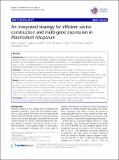An integrated strategy for efficient vector construction and multi-gene expression in Plasmodium falciparum
Author(s)
Lee, Marcus CS; Fidock, David A; Wagner, Jeffrey Charles; Goldfless, Stephen Jacob; Maddur Ganesan, Suresh; Niles, Jacquin; ... Show more Show less
Download1475-2875-12-373.pdf (929.5Kb)
PUBLISHER_CC
Publisher with Creative Commons License
Creative Commons Attribution
Terms of use
Metadata
Show full item recordAbstract
Background:
The construction of plasmid vectors for transgene expression in the malaria parasite, Plasmodium falciparum, presents major technical hurdles. Traditional molecular cloning by restriction and ligation often yields deletions and re-arrangements when assembling low-complexity (A + T)-rich parasite DNA. Furthermore, the use of large 5'- and 3'- untranslated regions of DNA sequence (UTRs) to drive transgene transcription limits the number of expression cassettes that can be incorporated into plasmid vectors.
Methods:
To address these challenges, two high fidelity cloning strategies, namely yeast homologous recombination and the Gibson assembly method, were evaluated for constructing P. falciparum vectors. Additionally, some general rules for reliably using the viral 2A-like peptide to express multiple proteins from a single expression cassette while preserving their proper trafficking to various subcellular compartments were assessed.
Results:
Yeast homologous recombination and Gibson assembly were found to be effective strategies for successfully constructing P. falciparum plasmid vectors. Using these cloning methods, a validated family of expression vectors that provide a flexible starting point for user-specific applications was created. These vectors are also compatible with traditional cloning by restriction and ligation, and contain useful combinations of commonly used features for enhancing plasmid segregation and site-specific integration in P. falciparum. Additionally, application of a 2A-like peptide for the synthesis of multiple proteins from a single expression cassette, and some rules for combinatorially directing proteins to discrete subcellular compartments were established.
Conclusions:
A set of freely available, sequence-verified and functionally validated parts that offer greater flexibility for constructing P. falciparum vectors having expanded expression capacity is provided.
Date issued
2013-10Department
Massachusetts Institute of Technology. Department of Biological EngineeringJournal
Malaria Journal
Publisher
BioMed Central Ltd
Citation
Wagner, Jeffrey C et al. “An Integrated Strategy for Efficient Vector Construction and Multi-Gene Expression in Plasmodium Falciparum.” Malaria Journal 12.1 (2013): 373.
Version: Final published version
ISSN
1475-2875